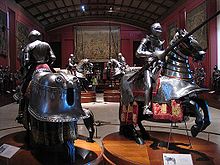
The Royal Palace of Madrid, also known as the Palacio de Oriente (English: The Orient Palace, or Far East Palace), is the official residence of the King of Spain in the city of Madrid, and it is only used for State Ceremonies.
However, King Juan Carlos and the Royal Family do not reside in it, choosing instead the more modest Palacio de la Zarzuela on the outskirts of Madrid. The palace is owned by the Spanish State and administered by the Patrimonio Nacional, a public agency of the Ministry of the Presidency.
The palace is located on Bailén Street, in the Western part of downtown Madrid, East of the Manzanares River, and is accessible from the Ópera metro station. The palace is partially open to public, except when it is being used for official business.
History
The site of the palace dates from a 10th-century fortress, called mayrit, constructed as an outpost by Mohammed I, Emir of Córdoba and inherited after 1036 by the independent Moorish Taifa of Toledo. After Madrid fell to Alfonso VI of Castile in 1085, the edifice was only rarely used by the kings of Castile. In 1329, King Alfonso XI of Castile convoked the cortes of Madrid for the first time. Philip II moved his court to Madrid in 1561.
The Antiguo Alcázar ("Old Castle") was built on the location in the 16th century. It burned on December 24, 1734; King Philip V ordered a new palace built on the same location. Construction spanned the years 1738 to 1755[1] and followed a Berniniesque design by Filippo Juvarra and Giovanni Battista Tiepolo in cooperation with Ventura Rodríguez, Francesco Sabatini, and Martín Sarmiento. The new palace, directly facing the cathedral across the Plaza de Armas, was occupied by Charles III in 1764.
[edit]Interior
The interior that is open to visitors consists of:
- the main staircase
- Halberdiers Room
- Hall of Columns
- Throne Room
- Saleta and antechamber of Charles III
- Chamber and bedroom of Charles III
- Gala Dining Room
- Music Room
- China collection
- Royal Chapel
- the imperial ballroom
- the imperial bedchamber
- 252 royal guest bedchambers
- the diplomatic foreeea'
- two grand maid's rooms
- the blue porcelain room
- the green porcelain room
- the red reception room
[edit]Today
The vast palace is richly decorated by artists such as Velázquez, Tiepolo, Mengs, Gasparini, Juan de Flandes, Caravaggio, and Goya. Several royal collections of great historical importance are kept at the palace, including the Royal Armoury and weapons dating back to the 13th century, and the world's only complete Stradivarius string quintet, as well as collections of tapestry, porcelain, furniture, and other objects of great historical importance.
Below the palace, to the west, are the gardens of the Campo del Moro that were given this name due to the fact that here in the year 1109, Muslim leader Ali ibn Yusuf, encamped with his men in the attempt to recapture Madrid and its Alcázar (fortress) from the Christians. The east façade of the palace gives onto the Plaza de Orienteand the Teatro Real opera house. To the south is a vast square, the Plaza de la Armas, surrounded by narrow wings of the palace, and to the south of that is located theCatedral de la Almudena. To the north are the Jardines de Sabatini (Sabatini Gardens), named after one of the architects of the palace.
On the Plaza de Armas facade, two life-size statues on both sides of the main entrance honor the two native Emperors from the Americas, Moctezuma, Emperor of the Aztecs, and Atahualpa, Emperor of the Incas.
The wedding banquet of Prince Felipe and Letizia Ortiz took place on 22 May 2004 at the central courtyard of the Palace.
The palace is open to the public and it is closed when used by the king for state functions like state banquets for visiting heads of state, official government receptions and the presentation of new ambassadors to the king.
Salam hormat - Puda















1 comment:
Coin Casino Review - Is it Safe to Play at a Curacao Casino?
Coin Casino 바카라 사이트 is a Curacao casino with games from Microgaming, Play'n GO, 인카지노 Pragmatic Play, In our review, we'll get information on how หาเงินออนไลน์ to deposit and withdraw.
Post a Comment